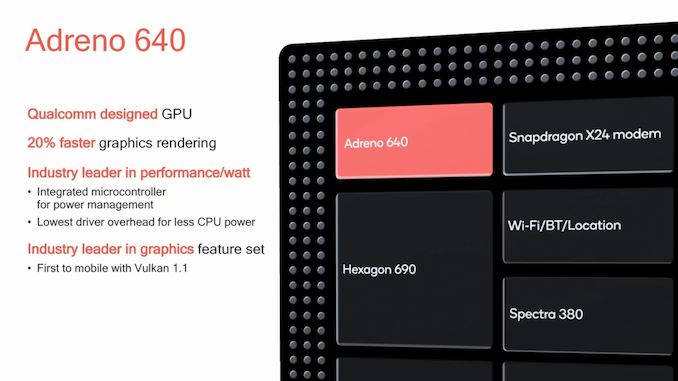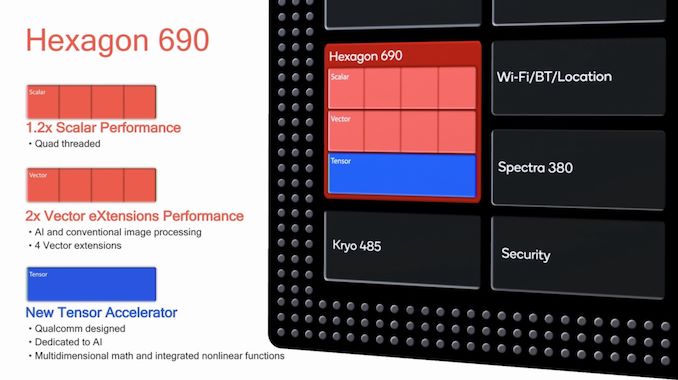The Samsung Galaxy S10+ Snapdragon & Exynos Review: Almost Perfect, Yet So Flawed
by Andrei Frumusanu on March 29, 2019 9:00 AM ESTThe Snapdragon 855 SoC - A Recap
Although the Galaxy S10 is the first Snapdragon 855 device we’re reviewing, Qualcomm’s new chipset shouldn’t come with any major surprises. We had the opportunity to conduct an extensive and in-depth performance preview back in January at CES, which answered a lot of our initial questions about Qualcomm's new flagship SoC. Indeed the Snapdragon 855 largely met our expectations: The new CPU on the new process node performs very similarly to the other 7nm + A76 design we've already seen – the Kirin 980 chipset from HiSilicon – with only minor differences on the CPU complex.
Where Qualcomm strongly differs from the competition is in in the auxiliary accelerator blocks such as GPU, DSP and the new tensor units. Let’s go over the specifications again:
| Qualcomm Snapdragon Flagship SoCs 2018-2019 | |||
| SoC |
Snapdragon 855 |
Snapdragon 845 | |
| CPU | 1x Kryo 485 Gold (A76 derivative) @ 2.84GHz 1x512KB pL2 3x Kryo 485 Gold (A76 derivative) @ 2.42GHz 3x256KB pL2 4x Kryo 485 Silver (A55 derivative) @ 1.80GHz 4x128KB pL2 2MB sL3 @ 1612MHz |
4x Kryo 385 Gold (A75 derivative) @ 2.8GHz 4x256KB pL2 4x Kryo 385 Silver (A55 derivative) @ 1.80GHz 4x128KB pL2 2MB sL3 @ 1478MHz |
|
| GPU | Adreno 640 @ 585MHz | Adreno 630 @ 710MHz | |
| Memory Controller |
4x 16-bit CH @ 2092MHz LPDDR4X 33.4GB/s 3MB system level cache |
4x 16-bit CH @ 1866MHz LPDDR4X 29.9GB/s 3MB system level cache |
|
| ISP/Camera | Dual 14-bit Spectra 380 ISP 1x 48MP or 2x 22MP |
Dual 14-bit Spectra 280 ISP 1x 32MP or 2x 16MP |
|
| Encode/ Decode |
2160p60 10-bit H.265 HDR10, HDR10+, HLG 720p480 |
2160p60 10-bit H.265 720p480 |
|
| Integrated Modem | Snapdragon X24 LTE (Category 20) DL = 2000Mbps 7x20MHz CA, 256-QAM, 4x4 UL = 316Mbps 3x20MHz CA, 256-QAM |
Snapdragon X20 LTE (Category 18/13) DL = 1200Mbps 5x20MHz CA, 256-QAM, 4x4 UL = 150Mbps 2x20MHz CA, 64-QAM |
|
| Mfc. Process | TSMC 7nm (N7) |
Samsung 10nm LPP |
|
The Snapdragon 855 is Qualcomm’s first SoC powered by Arm’s new Cortex-A76 CPU core, which we also saw in the Kirin 980. Qualcomm still makes use of Arm’s “Built on Cortex Technology” license, where it requests changes to the CPU IP to be delivered by Arm. The end product ends up marketed as a Kryo CPU – in the case of the Snapdragon 855 the new “Kryo 485” CPU.
In past iterations it’s not always been clear exactly what changes Qualcomm had made to the CPU cores, so it was a surprising and much welcomed change to have the company actually provide concrete examples in the case of the new Snapdragon 855 CPU cores: The two big disclosed changes are an increase of the core’s reorder buffer from 128 entries to a higher, unspecified amount, as well as tuning the prefetchers to better work with floating point workloads.
The one thing that makes the Snapdragon 855 unusual though is the new physical CPU configuration. Both the Kirin 980 as well as the Snapdragon 855 both contain four Cortex A76 cores, however the two companies implement these in two completely different ways.
While HiSilicon had opted for a 2+2 core configuration where one pair clocks up to 2.6GHz and the other only reaches 1.92GHz, Qualcomm opts to go with a 1+3 setup. Under Qualcomm's setup one core is clocked up to 2.84GHz, and meanwhile the other three cores reach up to 2.42GHz. While at first glance this makes sense, things get confusing when accounting for the fact that the Snapdragon still only has a single voltage plane for all four CPU cores, whereas the Kirin’s CPU pairs both have their dedicated rails.
Qualcomm has explained that this was a deliberate choice which took into account the actual benefits, as well as (most importantly) the costs of the platform. Having an additional voltage rail means your PMIC needs an additional buck converter and you need to have additional inductors and capacitors on the motherboard, a cost not only in terms of actual component costs but also in terms of valuable PCB space.
What this means is that the power difference between the two CPU groups is much less than one would expect, but most interestingly it will be a difference that is solely dictated by the different physical implementations of the two cores.
In later sections we’ll address the efficiency difference between the two groups of cores, and one thing that was surprising is that the “middle” cores weren’t that much more efficient than the “prime” core. I extracted the power curves out of the scheduler, as dictated by Qualcomm, and this reveals a bit more information and clarification.
What we see is that the middle “Gold” cores’ power curve shape is shifted down towards lower power, meaning it starts growing at an exponential rate earlier than what we see on the “Prime” core. This would explain why at peak performance, the efficiency difference between the two cores is minor. When we look at the middle frequency points in particular though, we see what this power difference is more notable and actually at its greatest point does represent up to 20% lower power on the mid cores compares to the prime core.
Qualcomm also differentiates the large CPU cores by their cache configuration: The Prime core gets 512KB of L2 while the middle cores make due with 256KB. The Cortex A55’s have the usual 128KB and Qualcomm clocks them conservatively at 1.78GHz.
Finally, the DSU’s L3 cache comes in at 2MB. A big question I had is exactly how fast Qualcomm had clocked the cache at, and the answer is 1.6GHz. This represents a slight increase over the 1478MHz of the L3 cache found in the Snapdragon 845.
Other large architectural changes in the Snapdragon 855 are the new Adreno 640 GPU. Here Qualcomm supposedly has increased the execution units by 50% - yet only advertise a 20% boost in performance. The explanation here lies in the clock frequency of the new GPU. The Adreno 640 in the Snapdragon 855 runs at only 585MHz, markedly slower than the 710MHz of the Adreno 630. I suspect that Qualcomm saw some of the increasing power usage of the higher clock frequencies and decided it’s better to go wider and slower. Indeed, we’ll see that the Snapdragon 855 has managed to reduce power usage in 3D workloads ever so slightly compared to the Snapdragon 845 – something which should definitely help thermals and sustained performance.
Finally, the new Hexagon 690 DSP block has seen its biggest change in several years. Scalar performance has gone up by 20% through microarchitectural and clock frequency bumps, but most importantly the DSP's vector unit count has been doubled up from two to four units, doubling the HVX performance of the new cores. This is something that will be particularly visible in the AI workloads we’ll cover shortly.
The new tensor accelerator block in the Hexagon IP is a new fixed function unit that is meant to be used for machine inferencing. Currently this unit should likely be exclusively used by Samsung’s first-party software such as the camera app, as Qualcomm won't make it available to NNAPI until later in the year in Android Q. As we’ll see later on, API compatibility and availability these days is going to be a bigger worry than actual hardware performance for these SoCs.














229 Comments
View All Comments
Liquidalloy - Friday, March 29, 2019 - link
That's why you should buy the unlocked variant. Right now I have the Verizon version of the s10 plus and there's very little bloatware. The phone is lightning fast btw.Jedi2155 - Friday, March 29, 2019 - link
As the bloatware typically doesn't impact my daily usage of the device nor consume a significant portion of the RAM/storage, I don't mind it. I actually find myself using much of the "extra" bloat they provide with the option to disable the ones I don't.When I use a stock AOSP build, I'm always searching for a feature or function that comes standard on Samsung....
0ldman79 - Saturday, March 30, 2019 - link
Go in and disable it.If you're really serious, root it, kill it and be done with it.
The Galaxy line have good hardware. Software can be dealt with.
I didn't buy my laptop for Windows 10, nor can I control what Dell puts on it, but I can certainly take it off.
SetiroN - Saturday, March 30, 2019 - link
Yeah, good luck formatting and installing a stock OS from an iso like you can with your dell laptop.What an asinine comment.
Shekels - Tuesday, April 2, 2019 - link
Dude have you ever rooted a phone? That's literally what you can do. Not an ISO but flash a Zip file and completely change your OS. The S10 is new and is pretty locked down, but some devs have already managed to root the thing and in the next couple months custom ROMs will emerge. It was like that for many Samsung phones on the past. The devs over at XDA have always manage to get root and custom ROMs on Samsung phones despite their attempts and totally locking down the phone.What an ignorant comment.
luisxfx - Monday, April 1, 2019 - link
I used to think the same thing, still kinda do, but I just hide or disable their icons, doesn't really make a difference, Galaxy S9 still runs smooth and quick.nathanddrews - Friday, March 29, 2019 - link
I upgraded from my S5 to the S10e at launch (T-Mobile, S855, 6GB/128GB). To be really honest, I was disappointed out of the box. The higher power button, locked bixby button, bloatware, default camera/video settings.The first real improvement I noticed was that all my apps opened instantly as opposed to waiting several seconds on my S5 (it was old and slower than when new, despite resetting the OS and trying difference ROMs).
The second improvement was the ridiculous battery life. I'm not a "power user" when it comes to cell phones. Text/email, pictures, videos, podcasts/music, and some web browsing. But still, 60% battery life at the end of every day (15hrs without charging) amazes me.
Now after a month of tweaking everything to my liking, I'm really happy with the phone overall. The speaker quality is really impressive - it's super loud without distorting much. The screen auto-brightness has adapted to my settings per app and depending on ambient light. The camera is only slightly disappointing. I must not hold the camera still enough, because a lot of my shots end up blurry/smeary when zooming in. I still need to work on dialing in those settings and trying some other camera mods.
nathanddrews - Friday, March 29, 2019 - link
I forgot to add that it felt a lot smaller in my hand (that's what she said) than my S5 due to the smaller overall bezel width. Now it's a lot more comfortable to use.Targon - Friday, March 29, 2019 - link
I also made the jump from the S5 to the S10, though I went with the regular S10, not the e. Not a single issue for me in any way(Snapdragon version, AT&T version). While there is still a fair amount of pre-installed apps, it doesn't feel as bloated as the S5 did with true garbage that I would never use but could not be uninstalled.liteon163 - Friday, March 29, 2019 - link
Part of your battery life issue could be due to an old battery in the S5. But manufacturers and Google certainly seem to plan obsolescence - ever higher specs are needed to keep up with the OS and bloatware.